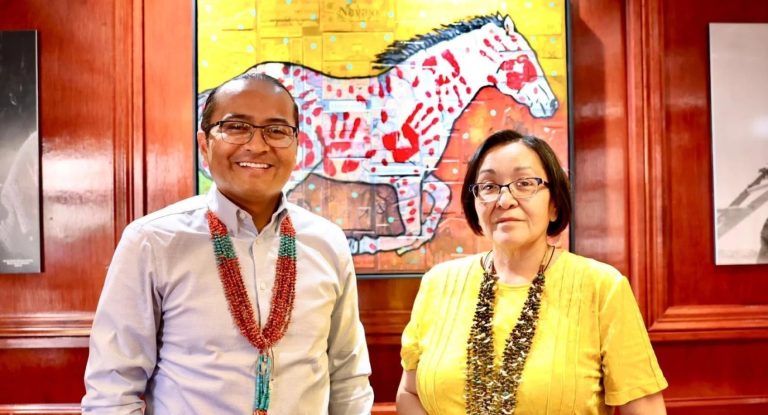Podcast: Play in new window | Download | Embed
Photo: Annmarie Decoteau, left, Indigenous curriculum and instruction specialist for Bismarck Public Schools, and Tomi Cimarosti, the district’s Indian Education director, on Monday, October 13, 2025. (Courtesy Annmarie Decoteau)
Thanksgiving is a holiday that often gives Native people mixed feelings.
Brian Bull of Buffalo’s Fire shares a few perspectives from across Indian Country.
One on hand, the romanticized depiction of Pilgrims and Indians happily feasting together in 1621 sidesteps the wars, disease, displacement, and oppression that came in the centuries afterwards.
Some Native people boycott Thanksgiving, and the United American Indians of New England will hold their 56th annual Day of Mourning this year, a protest held in Plymouth, Mass. since 1970.
On the other hand, Native people love to eat, with friends and family. What is one to do?
Annmarie Decoteau is the Indigenous curriculum and instruction specialist for Bismarck Public Schools.
A member of the Turtle Mountain Band of Chippewa, Decoteau helps educators teach about Thanksgiving from a more authentic Native perspective. And her family reframes holidays like Thanksgiving and the Fourth of July to be more relevant to them.
“So instead of celebrating the holidays, they celebrate still being here, the survival, the ancestor histories. they acknowledge what happened to us, that’s one thing I would like to push that we’re still here and that’s why we still celebrate: to keep our language, stories and culture still alive.”
And that Thanksgiving turkey might be pushed aside to make room for frybread, Indian tacos, and Decoteau’s personal favorite, wild rice casserole.
Someone else who has given the holiday a lot of thought is Nancy Kelsey (Anishinaabe of the Little River Band of Ottawa Indians), a columnist for Cleveland’s Plain Dealer newspaper.
She thinks it’s important Native people reflect on the holiday and make it their own.
“Given all of the centuries of labor on our ancestors’ part for us to be here as thriving people, there is no wrong way to celebrate Thanksgiving. We can make the holiday into something that is special for us.”
Kelsey says allies – including teachers – can learn about the tribes native to the lands they stand on, lift up and celebrate Indigenous storytellers, and speak up when racist and ignorant things happen.

The Gila River Indian Community’s Sacaton Market was unveiled during its grand opening on October 23, 2025. (Photo: Gabriel Pietrorazio / KJZZ)
The Gila River Indian Community in Arizona has long relied on convenience stores to feed its 13,000 residents, who otherwise may have to drive as far as half an hour away to neighboring cities with grocery stores.
But as KJZZ’s Gabriel Pietrorazio reports, a new market – a decade in the making – has opened much closer to home.
Duncan Winston is with Gila River Development and says the tribe’s new 11,000 sq. ft. supermarket in the heart of Sacaton is much more than a store.
“This isn’t a Bashas, it’s not a Safeway or a Walmart.”
It’s a symbol of their sovereignty since few, if any, tribes outright own their own grocers.
“We don’t want to leave that in the hands of a larger chain to determine who gets what – we want to be able to fight for ourselves and bring the necessary goods to our community when we need them.”
From fresh produce and butchered meats to a deli serving local favorites, like the work’s burger.
“One of the biggest demands from the community was, ‘You got to bring the works back.’ And so we’ve done that.”
But that doesn’t come cheap, because of what some refer to as “rez-flation”.
“We have experienced it here. I mean, it’s difficult finding reputable vendors who are willing to bring us goods and services at a fair price. Although we are rural, we are a lot closer to the metropolitan Phoenix area than a lot of the other tribes in Arizona.”
Get National Native News delivered to your inbox daily. Sign up for our daily newsletter today.
Download our NV1 Android or iOs App for breaking news alerts.
Check out the latest episode of Native America Calling




Leave a Reply